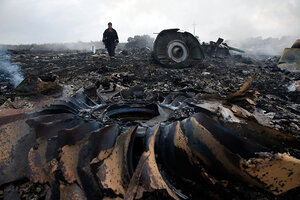Dutch report blames 'high-energy objects' for MH17 crash, no suspects named
Dutch investigators say cockpit recordings show no emergency in the moments before Malaysian Airlines Flight MH17 went down on July 17. Pro-Russian rebels fighting in eastern Ukraine are widely blamed for the incident.

An Emergencies Ministry member walks at a site of a Malaysia Airlines Boeing 777 plane crash near the settlement of Grabovo in the Donetsk region, July 17, 2014.
Maxim Zmeyev/Reuters/File
A daily roundup of terrorism and security issues.
A Malaysian Airlines passenger jet broke into pieces over Ukraine in July after it was struck by "high-energy objects from outside the aircraft,” according to a preliminary Dutch report.
“A full listening of the communications among the crew members in the cockpit recorded on the cockpit voice recorder revealed no signs of any technical faults or an emergency situation,” the Dutch Safety Board said in its report summary. “Neither were any warning tones heard in the cockpit that might have pointed to technical problems.”
The much-anticipated report released Tuesday stopped short of saying the Boeing 777 was shot down by a surface-to-air missile, and it did not say who was responsible for the July 17 incident, which took place over Ukrainian territory held by pro-Russian rebels. The investigators found "no evidence of technical or human error,” for the crash. A final report is expected by July 2015.
Kiev and the West have accused pro-Russian rebels armed with Russian surface-to-air missile launchers of downing the plane, which was flying between Amsterdam and Malaysia's capital Kuala Lumpur. Moscow denies any involvement and some officials have pointed a finger at Ukraine's government.
Tuesday’s report was issued just one day after the European Union announced new sanctions on the Kremlin over its role in the Ukrainian conflict, which has killed more than 3,000 people, including the nearly 300 who perished in the Malaysia Airlines flight.
A cease-fire has been in place in eastern Ukraine since Friday, but already four Ukrainian soldiers have been killed and tens have been injured, reports TIME.
Due to the ongoing violence in eastern Ukraine, the Dutch researchers have had limited access to the crash site, reports The BBC. Investigators relied on information gleaned from the plane’s black box flight recorders, air traffic control in both Ukraine and Russia, and photos and videos from the crash site to write their preliminary report. It took nearly a week after the crash for the first victim remains to be repatriated.
According to The New York Times:
For days [after the crash], bodies and debris were strewn across fields near the village of Grabavo, a separatist-controlled area not far from the border with Russia.
Much of the wreckage was left unguarded and accessible to journalists, mourners and curiosity-seekers, raising concerns that important evidence may have been tampered with.
Though report authors didn’t specify exactly what created the "high-energy objects" that brought down the plane, or who was responsible, many observers have started to use the report's preliminary findings to back up their own conclusions on the flight’s demise.
Australian Prime Minister Tony Abbott said, "The findings are consistent with the government's statement that MH17 was shot down by a large surface-to-air missile." Australia suffered the second-largest loss of life among citizens on the flight, with 38 Australians killed (there were 196 Dutch citizens on board).
Malaysian Prime Minister Najib Razak echoed this point of view in a written statement that noted the report’s key findings lead, “to the strong suspicion that a surface-to-air missile brought MH17 down.” He acknowledged that “further investigative work is needed before we can be certain."
An aviation safety specialist, Christopher Yates, told The Associated Press that the report "is extremely consistent” with damage from a missile because of the “penetration marks” on the plane:
"It must have been moving at very high velocity to create the damage," [Mr. Yates] said. "It could only be a missile of the type that would reach the altitude that would have struck the aircraft, potentially a Buk missile.
He said the report gave no indication whether the missile had been fired from the ground or from another aircraft, but it likely came from the ground as there were no military aircraft known to have been flying at the time. The missile could not have been shoulder-fired because it would not have reached the necessary altitude, he added.
A separate criminal investigation by prosecutors at The Hague is also underway, the BBC reports.

